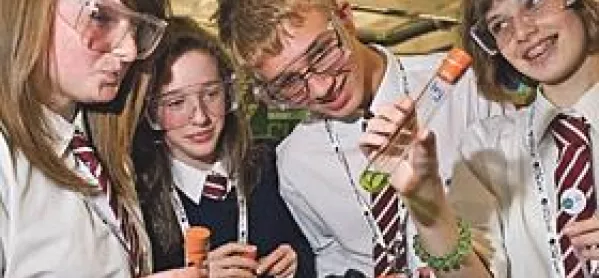Proof that science can be fun

There are all kinds of problems with doing experiments on humans - just ask Frankenstein. Even when people overcome their fears and volunteer, they don’t always turn up, says Andrew Crusher, one of the exhibitors at Scotland’s first Big Bang.
Organised by TechFest-SetPoint and hosted by the University of Abertay, the one-day event is a showcase for science and engineering innovation and investigation by 11 to 19-year-olds from 30 schools around the country. Awards on the day include Scotland’s best science project, engineering project, and poster, as well as the chance to represent Scotland at the National Science and Engineering Competition in London.
Andrew is one of the youngest exhibitors, a first-year pupil at Hutchesons’ Grammar in Glasgow, who has been investigating if humans can be conditioned in the same way as Pavlov’s dogs. “When people did come along, they’d get distracted,” he says. “So I put a screen around them. Then I was using a normal pipette, but it was too small. So I made a new one which gave a good, strong blow.”
The apparatus Andrew designed puffs air into faces while sounding a buzzer, the aim being to see if the buzzer alone will eventually trigger a blink. “It did with 85 per cent of them, which shows humans can be conditioned,” Andrew says. “It was an interesting experiment and I’ve ideas now for improving it and testing other hypotheses.”
That is what pupil-led projects are about, says Sir Roland Jackson, chief executive of the British Science Association, which runs the CREST Awards, the gateway to today’s event for many participants. “We want to give young people the creative space to see they can be scientists and engineers as well as learning about it.”
There’s a big difference, he says. “You need schoolwork too, but your own project puts that learning in context. It’s inspirational what young people do when they get to ask their own questions and design their own experiments to answer them.”
Some projects on display are not just educational but potentially useful as well.
“We built an ROV,” says Mearns Academy’s Rebecca Pettie, S6, pointing to a complex-looking, chunky little craft, made of plastic pipes, silver motors and black propellers. “That’s a remotely operated vehicle. People use them to do tasks underwater. We had done a bit of work on one last year, then we improved it this year.”
Improvements were extensive, says Sam Jarvis, S6, who is aiming for a career in engineering. “We worked on manoeuvrability, function, safety and aesthetics. There were six of us with a wide range of skills and we worked well together. Our biggest problem was finding a testing tank as we didn’t have one at school.”
That meant lots of calculations, says Rebecca. “When we tried it out at Robert Gordon’s University, it worked near-perfectly. We entered a competition for young engineers and came fourth.”
Winning awards is not what the Big Bang is about for chemistry teacher Helen Armstrong and her Grove Academy pupils. Unlike many schools, represented by committed young scientists, Grove took a more democratic route, she says. “Everybody did a poster inspired by a distillery visit which we tied into enterprise. Then we drew names. We have all kinds of young people in our science club, including the autistic unit. It’s inclusive, so the process for us was more important than a prize.”
Her pupils are nevertheless being rigorously judged, as are all exhibitors, by a group of experts who circulate in pairs and question participants. The Grove girls are being grilled by physicist and former weather presenter Heather Reid and Anne Glover, chief scientific adviser to the Scottish Government.
“What is it that makes Scotland so good for whisky?” Dr Reid wonders and the youngsters offer several suggestions, such as the land and the water. “Yes, but more importantly, our weather,” she replies.
Arriving at the Renfrew High exhibit, where S6 pupils have devised a solution that could save engineering firm Howden thousands of pounds, she is met with a question from Graeme Cleary: “Do you know what a turbo- compressor does?”
“Compresses?” she smiles. “Hang on, I’m asking the questions.”
For the next 10 minutes she does so, receiving answers on their six-month project from Graeme and colleagues Kunzah Jamal, Jaspreet Kainth and Arif Nadeem.
“We did experiments on the forces acting on the shaft and also on the properties of the materials to protect it,” Kunzah explains. “We didn’t just pull them out of thin air.”
That was impressive, Dr Reid comments as she moves on, and Professor Glover agrees: “I feel a bit in awe,” she says. “Many of the projects are sophisticated and thoughtful, and it’s great to see their excitement.
“I tell people science is fun and they look at me in disbelief. But these kids know that it’s true. They’re having fun with people they came with and meeting people from other schools. They are realising there is a community of scientists and engineers out there, and discovering that all this collaboration and excitement is what their lives could be like.”
douglas.blane@tes.co.uk
Awards board
Prizes supported by the Scottish Government
- Best overall science project
- Best overall engineering project
Decorative garden gate by Duncan Ledingham of Merchiston Castle School (teacher Freddie Main)
Conditioned learning in humans by Andrew Crusher of Hutchesons’ Grammar, Glasgow (teacher John Di Mambro)
Keep reading for just £1 per month
You've reached your limit of free articles this month. Subscribe for £1 per month for three months and get:
- Unlimited access to all Tes magazine content
- Exclusive subscriber-only stories
- Award-winning email newsletters


